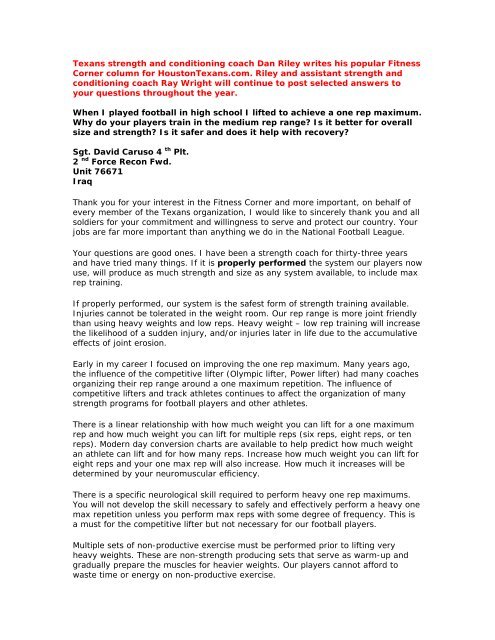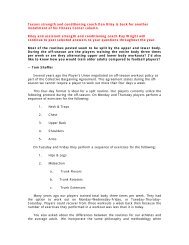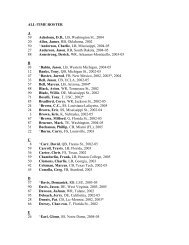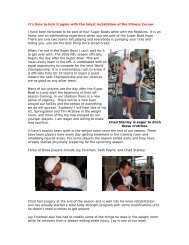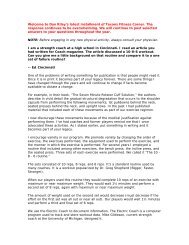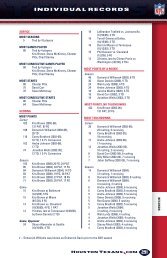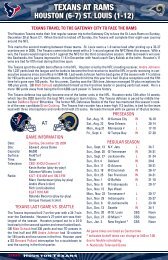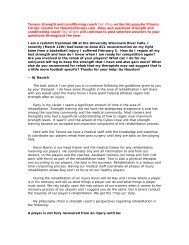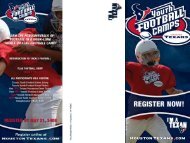Texans strength and conditioning coach Dan Riley writes his ...
Texans strength and conditioning coach Dan Riley writes his ...
Texans strength and conditioning coach Dan Riley writes his ...
You also want an ePaper? Increase the reach of your titles
YUMPU automatically turns print PDFs into web optimized ePapers that Google loves.
<strong>Texans</strong> <strong>strength</strong> <strong>and</strong> <strong>conditioning</strong> <strong>coach</strong> <strong>Dan</strong> <strong>Riley</strong> <strong>writes</strong> <strong>his</strong> popular FitnessCorner column for Houston<strong>Texans</strong>.com. <strong>Riley</strong> <strong>and</strong> assistant <strong>strength</strong> <strong>and</strong><strong>conditioning</strong> <strong>coach</strong> Ray Wright will continue to post selected answers toyour questions throughout the year.When I played football in high school I lifted to achieve a one rep maximum.Why do your players train in the medium rep range? Is it better for overallsize <strong>and</strong> <strong>strength</strong>? Is it safer <strong>and</strong> does it help with recovery?Sgt. David Caruso 4 th Plt.2 nd Force Recon Fwd.Unit 76671IraqThank you for your interest in the Fitness Corner <strong>and</strong> more important, on behalf ofevery member of the <strong>Texans</strong> organization, I would like to sincerely thank you <strong>and</strong> allsoldiers for your commitment <strong>and</strong> willingness to serve <strong>and</strong> protect our country. Yourjobs are far more important than anything we do in the National Football League.Your questions are good ones. I have been a <strong>strength</strong> <strong>coach</strong> for thirty-three years<strong>and</strong> have tried many things. If it is properly performed the system our players nowuse, will produce as much <strong>strength</strong> <strong>and</strong> size as any system available, to include maxrep training.If properly performed, our system is the safest form of <strong>strength</strong> training available.Injuries cannot be tolerated in the weight room. Our rep range is more joint friendlythan using heavy weights <strong>and</strong> low reps. Heavy weight – low rep training will increasethe likelihood of a sudden injury, <strong>and</strong>/or injuries later in life due to the accumulativeeffects of joint erosion.Early in my career I focused on improving the one rep maximum. Many years ago,the influence of the competitive lifter (Olympic lifter, Power lifter) had many <strong>coach</strong>esorganizing their rep range around a one maximum repetition. The influence ofcompetitive lifters <strong>and</strong> track athletes continues to affect the organization of many<strong>strength</strong> programs for football players <strong>and</strong> other athletes.There is a linear relationship with how much weight you can lift for a one maximumrep <strong>and</strong> how much weight you can lift for multiple reps (six reps, eight reps, or tenreps). Modern day conversion charts are available to help predict how much weightan athlete can lift <strong>and</strong> for how many reps. Increase how much weight you can lift foreight reps <strong>and</strong> your one max rep will also increase. How much it increases will bedetermined by your neuromuscular efficiency.There is a specific neurological skill required to perform heavy one rep maximums.You will not develop the skill necessary to safely <strong>and</strong> effectively perform a heavy onemax repetition unless you perform max reps with some degree of frequency. T<strong>his</strong> isa must for the competitive lifter but not necessary for our football players.Multiple sets of non-productive exercise must be performed prior to lifting veryheavy weights. These are non-<strong>strength</strong> producing sets that serve as warm-up <strong>and</strong>gradually prepare the muscles for heavier weights. Our players cannot afford towaste time or energy on non-productive exercise.
More important than the number of repetitions performed is the amount of time amuscle is placed under load <strong>and</strong> at what intensity. Once you begin the first rep ofan exercise start a watch <strong>and</strong> stop it when you finish the last rep. The time elapsedis time under load.Through the years we have experimented with many different set/rep combinations<strong>and</strong> have obtained the best results when eight to twelve reps are performed whilestrictly adhering to our five <strong>Texans</strong> “Rep Rules.”It is important for our players to recruit every available muscle fiber if maximum<strong>strength</strong> gains are to be developed <strong>and</strong> injury prevention is a priority. Performingsomewhere between eight <strong>and</strong> twelve reps accomplishes t<strong>his</strong> in the most timeefficient <strong>and</strong> safest manner possible.Sgt. Caruso, please remember that all rep ranges work if, adequate overload isprovided. However, during the season our players have very little time or energy towaste in the weight room. Total body <strong>strength</strong> is a priority for our <strong>Texans</strong> <strong>and</strong> theintent of every exercise performed must be to maintain near maximum <strong>strength</strong>levels. Gearing an in-season workout for a one maximum repetition will notaccomplish t<strong>his</strong>.I wish you <strong>and</strong> all of the soldiers in your platoon <strong>and</strong> company the best of luck. Stayhealthy, train hard, <strong>and</strong> come home safe. Thank you again for serving our country.I am a twenty-six year old amateur football player. Many “traditional”programs encourage sets of one to six reps for most multi-joint exerciseslike the bench press <strong>and</strong> squat. I would like to hear why you prefer higherrep ranges in training your players?Kalle KarppinenHelsinki, Finl<strong>and</strong>Your question is similar to the one above <strong>and</strong> one that I am asked frequently.Remember, more important than the number of reps you perform is how youperform each individual rep <strong>and</strong> how you complete each set.I have already mentioned that multiple sets are necessary when the rep range islow. You cannot expect to generate maximum gains in <strong>strength</strong> if only one set of onerep is performed. Multiple sets must be performed to activate <strong>and</strong> gradually fatiguemore muscle fibers when only a few reps are performed. Due to the accumulativeeffect each additional set brings more muscle fibers into play. We can accomplisht<strong>his</strong> simply by increasing the number of reps.Our goal is to perform as little exercise as possible yet produce the absolute bestgains in <strong>strength</strong>. We have learned through experience that keeping the rep rangebetween eight <strong>and</strong> twelve reps best improves our player’s <strong>strength</strong>, but it also has amajor impact on their short-term endurance.I do not know what takes place within the muscle, but there appears to be significantmetabolic changes with a higher rep range (eight to twelve reps) that do not occurwith heavy weight low rep schemes. These metabolic changes allow an athlete to
perform more work at a higher level of intensity <strong>and</strong> also help them to recoverquicker.Performing a few heavy reps will increase <strong>strength</strong> but will have less impact on aplayer’s short-term endurance which is necessary for a football player <strong>and</strong> lessimportant for a weight lifter or shot putter.If low rep schemes are the best way to build <strong>strength</strong> for a football player then allexercises (neck, shoulders, back, arms, etc.) should be performed in t<strong>his</strong> manner,not just a few. T<strong>his</strong> would be impractical <strong>and</strong> impossible for our players.I am a volunteer <strong>coach</strong> here in Br<strong>and</strong>on <strong>and</strong> had the pleasure of watchingone of your team practices in previous years. I would appreciate it verymuch if you could provide some information regarding stretching exercises<strong>and</strong> flexibility in order to prevent injuries.C. TaylorBr<strong>and</strong>on, ManitobaCanadaStretching is a low intensity exercise designed to increase range of motion. Keep inmind each stretch is performed in a static <strong>and</strong> controlled manner. The number ofmuscle fibers involved is limited to the specific plane being stretched.Eventually the range of motion of all involved muscle fibers will be determined by theactivities performed on the field at game speed. We cannot recreate the violentforces <strong>and</strong> excessive range of motion caused by an athlete stopping, twisting,turning, <strong>and</strong> running at full speed. Our most flexible players will experience unduemuscle soreness when they begin practicing at full speed.Stretching is not a warm-up. For an activity to be considered a warm-up you mustincrease core tissue temperature enough to break a sweat. Core temperature isunaffected by stretching.There is a time <strong>and</strong> place to stretch if an increase in flexibility is the desired effect.There is very little research that supports an increase in flexibility will prevent aninjury.Dr. Bob O’Connor, from Olso, Norway, published an article in the January, 2003,Coach & Athletic Director, titled “Stretching the Truth: It Is No Bargain.”O’Connor states, “At various times in our <strong>his</strong>tory, we have believed that the world isflat, diseases are caused by evil spirits, <strong>and</strong> warm-up stretching prevents injuries<strong>and</strong> enhances performance. All of these premises are wrong, although the scientificliterature is just beginning to question the validity of stretching as a warm-up.”In the April 27, 2004 New York Times, Lorraine Kreahling published an article titledNew Thoughts About When Not to Stretch. Kreahling reported about a major studyconducted by the Centers for Disease Control <strong>and</strong> Prevention. The study reviewed sixdecades of research to evaluate the impact stretching had on injury prevention. Itwas determined that stretching does little to prevent injury during exercise.
My advice to our players is warm-up before stretching. If you stretch it should be toimprove your flexibility, not to prevent an injury.I am 16 years old <strong>and</strong> play football in Engl<strong>and</strong>. I am looking for the bestworkout for a middle linebacker? How do your routines vary from positionto position?Nik HaywoodLogic dictates that once you find the “best” <strong>strength</strong> training workout for alinebacker, it should also be the same workout used by a quarterback, linemen, widereceiver, or any position.The number one priority for all athletes, regardless of position, must be short <strong>and</strong>long-term injury prevention. When a <strong>coach</strong> finally finds the ultimate “best workout,”it must be utilized by all players (regardless of position).The function of your muscles is the same as any member of your team (regardless ofposition). Our goal is to find those methods producing the best results <strong>and</strong> thenemploy those techniques with every member of our team.Once a <strong>strength</strong> <strong>coach</strong> finds out how to best develop <strong>strength</strong>, all players should usethe same routines. The only difference will be the degree of development. With thesame effort, some athletes will respond better than their teammates, simply becausethey possess a better genetic predisposition for adding muscular size <strong>and</strong><strong>strength</strong>.We all possess some ability to add muscle <strong>strength</strong> <strong>and</strong> size. An athlete with the bestphysiological, anatomical, neurological, <strong>and</strong> biomechanical, advantages will respondthe most.During <strong>his</strong> induction speech at the National Football League Hall of Fame, formerPenn State offensive linemen Mike Munchak acknowledged me <strong>and</strong> the <strong>strength</strong>program at Penn State for adding forty-five pounds of muscle during <strong>his</strong> first twoyears at Penn State.I have explained to “Munch” that he was a big person with a big frame <strong>and</strong> had verygood developing potential. Through the normal maturation process he was going togain a significant amount of weight whether he lifted weights or not. One of theadvantages of being a college <strong>strength</strong> <strong>coach</strong> is capitalizing on the maturationprocess. Most college athletes generate some of their best physical gains betweenthe ages of eighteen <strong>and</strong> twenty years-old.At Penn State all of our players used the same routines yet few of our playersresponded with the same degree of muscular <strong>strength</strong> <strong>and</strong> size as did Mike Munchak.Far more important than the routine, the sequence of exercises, the set/repcombination, or the equipment used, is the genetic potential of the individualathlete.For an athlete to generate significant <strong>strength</strong> gains there are certain genetic assetsshe/he must possess. If you are blessed with a higher degree of these assets you will
espond more favorably (regardless of the program, equipment, set/rep combinationyou use).T<strong>his</strong> physiological phenomenon can be observed with competitive weightlifters.Weight classes range from the super lightweight to the super heavyweight. Each ofthe competitive weightlifters uses the same methods, techniques, <strong>and</strong> equipment,yet the gains in <strong>strength</strong> <strong>and</strong> degree of development is different.T<strong>his</strong> same physiological phenomenon exists with our players. Each position requiresa specific job description. Remember, the function of an activity dictates the physicaldesign of the athlete.The physical dem<strong>and</strong>s of defensive lineman on the field are different than thephysical dem<strong>and</strong>s of a defensive back. Gary Walker <strong>and</strong> Aaron Glenn are both ProBowl players. Yet if we asked them to switch positions each would fail miserably. Itwould be impossible for Gary to cover speedy receivers <strong>and</strong> just as impossible forAaron to take on mammoth offensive linemen at the line of scrimmage.Gary <strong>and</strong> Aaron each possess the same muscles. They both use the same <strong>Texans</strong>weight workouts. What is the physical difference between how much Gary <strong>and</strong> Aaronrespond to the same workout? Obviously Gary has better potential to add muscular<strong>strength</strong> <strong>and</strong> size due to the position he plays <strong>and</strong> the developing potential he musthave. That is why he is a defensive lineman <strong>and</strong> Aaron is a defensive back. It hasnothing to do with the exercises performed, the set/rep combination, or theequipment used.Organizing a <strong>strength</strong> program for a football player (<strong>and</strong> most athletes) is easy. Totalbody <strong>strength</strong> is a priority. We divide the body into five major segments:1. Neck2. Hips & Legs3. Midsection4. Upper Body5. ArmsRefer to past installations of the Fitness Corner <strong>and</strong> our player’s training manual forguidance on how to perform an exercise <strong>and</strong> organize a workout.All athletes should have the same opportunity to experience the same muscularbenefits. If there is a program that is “best,” common sense dictates that all athletesshould use t<strong>his</strong> program.Ray, Everett, Virgil, <strong>and</strong> myself, are constantly looking for safer, efficient <strong>and</strong> moreeffective methods, to generate maximum gains in <strong>strength</strong>. If we find a better wayNik, we will implement those methods all of our players, not just our linebackers.


